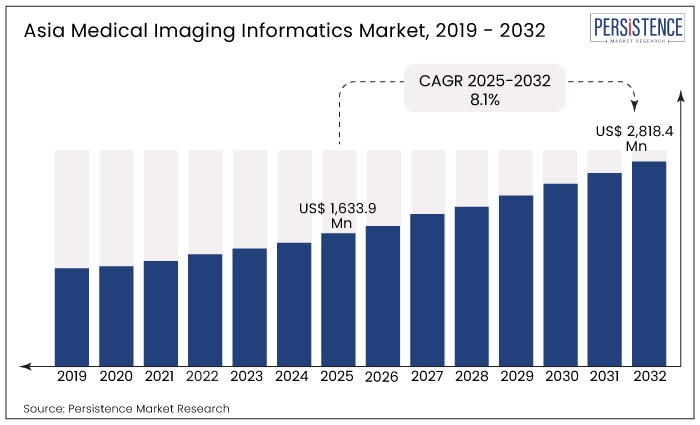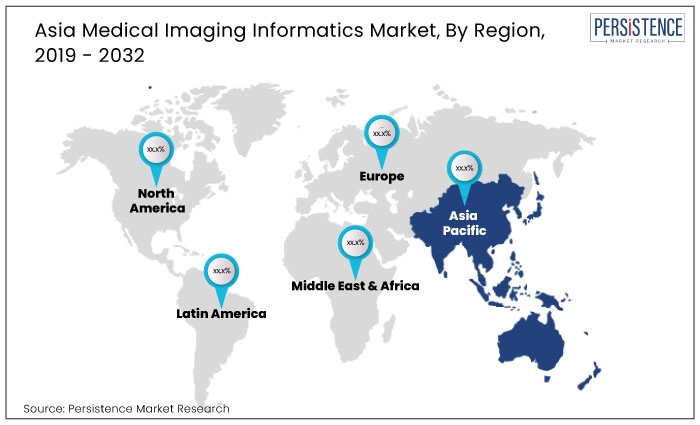ID: PMRREP33460| 195 Pages | 22 Jul 2025 | Format: PDF, Excel, PPT* | Healthcare

The Asia medical imaging informatics market was valued at US$ 1,522.70 million in 2024 and is expected to reach US$ 1,633.9 million by the end of 2025. During the assessment period (2025 to 2032), the market is projected to expand rapidly at a CAGR of 8.1% to end up at a market size of US$ 2,818.4 million by 2032.
Medical Imaging Informatics (MII) is a branch of medical informatics concerned with the storage, retrieval, analysis, and distribution of medical images as well as related data and information.
MII involves the use of computer technology to organize and process many types of medical images, such as X-rays, CT scans, MRIs, ultrasound images, and others. This field blends information technology, computer science, and medical imaging principles to provide effective and efficient medical image management for clinical and research applications.
Revenue from medical imaging informatics in Asia accounts for nearly 18% share of the global medical imaging informatics market.
 Image processing, image analysis, visualization, and decision assistance tools are examples of MII applications. The field is crucial for proper patient diagnosis, treatment, and management in healthcare settings. MII is critical for medical imaging research and innovation, leading to new diagnostic and therapeutic approaches.
Image processing, image analysis, visualization, and decision assistance tools are examples of MII applications. The field is crucial for proper patient diagnosis, treatment, and management in healthcare settings. MII is critical for medical imaging research and innovation, leading to new diagnostic and therapeutic approaches.
| Attributes | Key Insights |
|---|---|
|
Asia Medical Imaging Informatics Market Size (2025) |
US$ 1,633.9 million |
|
Projected Market Value (2032) |
US$ 2,818.4 million |
|
Market Growth Rate (2025 to 2032) CAGR |
8.1% |
| Historical Market Growth Rate (CAGR 2019 to 2024) |
7.3% |
“Lack of Expertise in Operating Medical Imaging Informatics Systems and High Installation Cost”
Medical imaging informatics systems require specialized knowledge and training to operate, and many healthcare professionals lack the expertise needed to use them effectively. The complexity and technical nature of medical imaging informatics systems can make it challenging for healthcare professionals to operate and utilize the systems effectively, leading to a slow adoption rate.
Healthcare organizations require ongoing training and support to operate medical imaging informatics systems effectively. The lack of expertise in-house means that organizations may need to rely on vendors for support, which can be costly and time-consuming.
The high cost of purchasing and implementing medical imaging informatics systems and licensing cost of software can make it difficult for smaller healthcare organizations to adopt the technology with low financial resources, thus limiting market growth.
The price of treatment also differs depending on whether it is performed in a private or public hospital, a diagnostic center, or an ASC. The price of a diagnostic may differ based on the healthcare system. The high expense of medical imaging techniques may prevent more people from using them, particularly in underdeveloped nations.
The cost of maintaining and upgrading medical imaging informatics systems can be high, and many healthcare organizations may not have the necessary expertise to do this in-house. This leads to additional expenses, making the solutions less appealing.
Lack of expertise in operating medical imaging informatics systems and high installation costs are two major factors that can negatively impact the growth of the market in Asia.
How is Demand for Medical Imaging Informatics Systems Shaping Up in India?
“Expanding Healthcare Sector and Increasing Need for High-quality Healthcare Services”
The Indian healthcare sector has expanded significantly in recent years, which has had a substantial impact on the market. One of the key drivers of this expansion is the country's increasing demand for high-quality healthcare services.
Chronic diseases such as cancer, diabetes, and cardiovascular disease are on the rise as healthcare services become more widely available, as income levels rise and lifestyles change. Because these diseases necessitate advanced medical imaging technologies and informatics solutions for accurate diagnosis and treatment, demand for medical imaging informatics solutions is increasing.
The Indian market is projected to expand at a CAGR of 17.5% from 2025 to 2032.
What is the Demand Outlook for Medical Imaging Informatics Solutions in Singapore?
“Increasing Government Investments in Healthcare Sector Fueling Demand for Medical Imaging Informatics”
The government of Singapore has made significant investments in the healthcare industry, with the goal of creating a high-quality, easily accessible healthcare system. The government has undertaken several initiatives and funding programs to help the healthcare sector thrive, including the provision of medical imaging informatics systems.
The government's Research, Innovation, and Enterprise (RIE) 2025 plan includes major investments in healthcare research and development, including medical imaging informatics. The plan's goal is to encourage the development of new technologies and solutions that will improve the quality and efficiency of healthcare services in Singapore.
What Makes Indonesia a Lucrative Market for Providers of Medical Imaging Informatics Systems?
“High Demand for Medical Imaging Systems Due to Rising Incidence of Chronic Diseases”
Medical imaging informatics systems are critical in the identification, diagnosis, and treatment of chronic diseases, especially in the early stages when symptoms may not be apparent. Medical imaging informatics can give precise and detailed images of the damaged area, allowing healthcare providers to diagnose the disease and establish an effective treatment plan.
As the prevalence of chronic diseases in Indonesia continues to rise, so will the demand for medical imaging informatics systems and solutions. This trend creates an opportunity for healthcare providers and medical technology businesses in the country to invest in the development and expansion of medical imaging informatics services.
Indonesia accounts for 10.2% share of the Asia medical imaging informatics market in 2024.

Why are Radiology IT Solutions in High Demand across Asia?
“Ever-increasing Need for Efficient Image Processing and Improved Patient Outcomes”
The healthcare business is undergoing a technological revolution, which includes the use of artificial intelligence, machine learning, cloud computing, and 3D printing. These improvements are paving the way for the creation of more sophisticated and efficient radiology IT systems that can increase the accuracy and speed of image processing, diagnosis, and treatment planning.
Growing use of electronic health records (EHRs) is driving the demand for radiology IT solutions that can integrate with existing healthcare IT systems. This interface enables healthcare practitioners to share medical imaging data in real time, enhancing care coordination and patient outcomes.
The radiology IT solutions segment occupies 45.9% of the Asia market.
Why are Medical Imaging Informatics Systems Extensively Used in Ultrasound Applications?
“Growing Demand for Minimally-Invasive Procedures Leading to Increased Utilization of Advanced Medical Imaging Informatics Systems”
Medical imaging informatics is crucial in enabling minimally invasive operations by delivering precise and detailed images of the targeted area. This enables healthcare providers to precisely pinpoint the target and carry out the surgery with more precision and safety.
Ultrasound imaging is a popular imaging technique for minimally invasive treatments such as biopsies, aspirations, and injections. The growing need for these procedures drives the demand for medical imaging informatics in the ultrasound segment.
The ultrasound segment is set to advance at a 17.5% CAGR during the forecasted period.
Prominent companies in the Asia medical imaging informatics market are prioritizing partnerships and collaborations with international players to enhance and upgrade their products, ultimately aiming to gain a significant market share in Asia.
The market is expected to reach US$ 2,818.4 million by 2032.
The market is projected to grow at a CAGR of 8.1% during this period.
It was valued at US$ 1,522.70 million in 2024.
Radiology IT solutions hold the largest share at 45.9%.
Asia accounts for nearly 18% of the global medical imaging informatics market.
| Attribute | Details |
|---|---|
|
Forecast Period |
2025 to 2032 |
|
Historical Data Available for |
2019 to 2024 |
|
Market Analysis |
Value: US$ Bn, Volume: As applicable |
|
Key Countries Covered |
|
|
Key Market Segments Covered |
|
|
Key Companies Profiled |
|
|
Pricing |
Available upon Request |
By Product:
By Application:
By Deployment:
By End User:
By Country:
Delivery Timelines
For more information on this report and its delivery timelines please get in touch with our sales team.
About Author